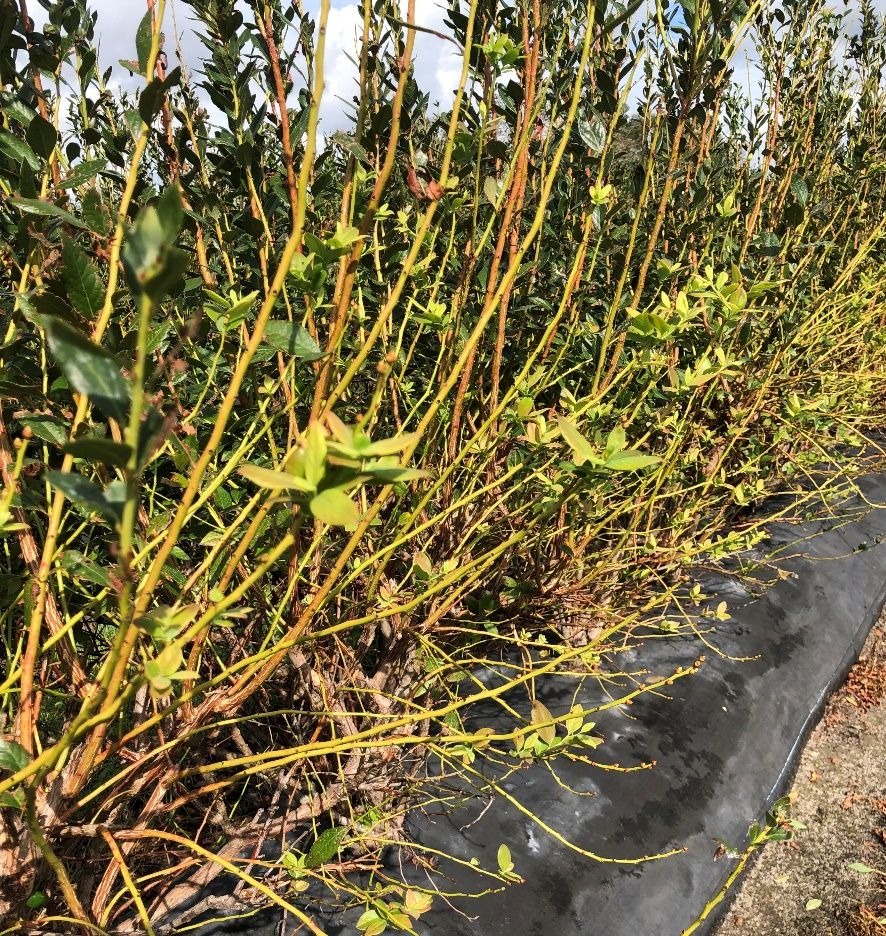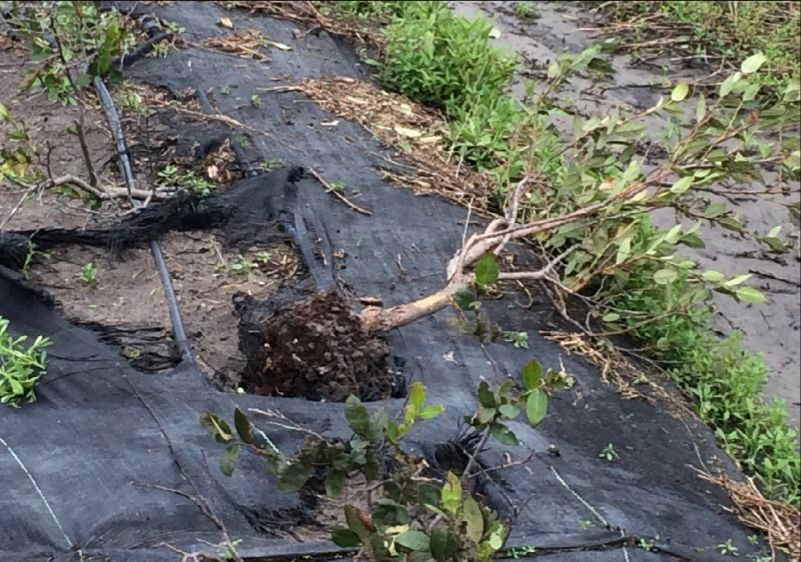Impacts of Hurricane Damage on Southern Highbush Blueberries
Florida has been affected by nine hurricanes since 2000. As of this article’s writing, Hurricane Ian was the most recent major storm to affect the state (September 2022). Ian made landfall in southwest Florida as a Category 4 storm with maximum sustained wind speeds of 150 mph and accumulated rainfall of up to 20 inches in some areas. Prior to that, Hurricane Michael hit the Florida panhandle in 2019 with sustained winds of 160 mph, and Hurricane Irma made landfall in southwest Florida in 2017 with winds up to 112 mph and accumulated rainfall of up to 14 inches. Each of these storms caused significant property damage across the state, including damage to agricultural crops.
Estimated agricultural production losses in Florida from Hurricane Ian are $1.03 billion. This includes $137.7 million for non-citrus fruit, with the most significant estimated losses in Hardee, Hillsborough, Manatee, and Polk Counties. For Irma, over 5.0 million acres of cropland were affected, including 3.4 million under hurricane-force winds. Total crop sales losses were estimated in excess of $1.5 billion. This publication discusses the types of hurricane damage that can be incurred in blueberry production operations, the impacts of these damages, preparations to make before the storm arrives, and suggestions on best management practices in the aftermath of a storm.
Wind Damage
Hurricane-force winds are sustained winds of at least 74 mph, which can increase to more than 156 mph with a Category 5 storm. Winds of this magnitude, or even tropical storm force winds (between 39 and 73 mph), can cause significant damage to blueberry plants, including defoliation and uprooting.
Significant defoliation of blueberry plants was observed on some farms in south Florida after Hurricanes Irma and Ian (Figure 1), as was wind damage to the remaining foliage (Figure 2). Defoliation can have a significant impact on blueberry production even before there are flowers or fruit present on the plants: flower bud number is the most important predictor of yield in blueberries. The amount of late summer/fall flower bud initiation and development determines yield, and bud development depends on plants having a full and healthy canopy of foliage. Early fall (September and October) defoliation of southern highbush blueberry plants can affect bloom time and reduce the number of flower buds that develop and/or the number of berries produced per flower bud. The impact of defoliation and other wind damage to remaining leaves could be even more significant on blueberry plants grown in an evergreen system, where it is important to maintain healthy foliage throughout the fall, winter, and early spring; consistently healthy foliage helps support the next year’s crop and achieve early yields of high-quality fruit. The blueberry defoliation that can occur during a hurricane can thus have a major impact on the following season’s crop. Following Hurricane Ian, some growers experiencing wind damage reported lower fruit set on some cultivars and later fruit maturity. In addition, significant variability by cultivar was observed in the emergence of new foliage following defoliation. This is an area where additional research is needed to further clarify potential impacts on yield, as well as bloom and fruit maturity timing.

Credit: D. Phillips, UF/IFAS

Credit: D. Phillips, UF/IFAS
Hurricane-force winds can also cause damage by uprooting blueberry plants (Figure 3), resulting in the need to reset and stake these plants. Also, potential breakage of woody stems and the root system can significantly impair transport of water and nutrients throughout the plant, which results in delayed, stunted growth and serious plant stress that can persist for weeks or even months. Wounds also provide entry points for several stem and root pathogens. Severe plant stress often leads to significant outbreaks of Botryosphaeria stem blight, sometimes months after the wind damage and plant stresses occur.

Credit: J. Gross
Flooding
Flooding from a hurricane or tropical storm can create multiple problems for blueberries because there can be standing water in the fields for several days following a significant storm (Figure 4). Blueberry plants generally do not tolerate saturated conditions well.

Credit: D. Chapman
Root death can occur when there is no oxygen in the root zone due to saturated conditions (hypoxia). Flooding can reduce root and shoot growth, reduce leaf number, inhibit leaf expansion, increase leaf abscission, reduce nutrient uptake, and result in smaller flower buds and fruit. Each of these factors can have a detrimental impact on the following season’s yield. Minimizing the length of time that flooded conditions persist by pumping water from the field may help to limit this damage. One disease that thrives in flooded conditions is Phytophthora root rot. The water mold pathogen Phytophthora cinnamomi has swimming zoospores that spread readily through surface water, and saturated conditions with root wounding are an ideal scenario for infection of blueberry roots by these spores.
Disease
The three factors that must be present for plant disease are an active pathogen, favorable environmental conditions for disease development, and a susceptible host. Each of these factors can be affected by a hurricane.
Pathogen—High winds and rising waters can spread pathogens into and throughout a production field to areas where they may not have been present previously.
Environment—flooded soils and extended rain events associated with a major storm, along with the hot and humid weather typical for Florida during summer and early fall, are ideal conditions for successful pathogen infections into blueberry plants. These same conditions also promote post-infection symptom development and continued spread of many blueberry diseases.
Plant Host—blueberry plants that suffer the types of storm damage discussed above are considerably stressed. Stressed and wounded plants have fewer defenses against pathogen infection and disease development. Diseases like Botryosphaeria stem blight often become much more prevalent in a field of stressed plants, and stressed plants are also more likely to die from the disease when it occurs compared to infected plants in fields not stressed by storm damage and conditions.
Before the Storm—Farm Preparations
- Check fields for surface water drainage. Ensure that ditches, canals, areas between beds, and the ends of rows are clear and that water can flow freely out of production fields.
- Make sure to have sufficient diesel fuel on hand to operate farm equipment and drainage pumps.
- Check that generators and chainsaws are working properly.
- Scout for potential debris and secure items that may be propelled by strong winds before the storm.
- Purchase materials for resetting plants blown over during the storm (e.g., bamboo stakes and tie tape).
- Purchase mefenoxam containing products (e.g., Ridomil, Ultra Flourish, Orondis, etc.) and phosphorous acid products (“phytes”) to manage Phytophthora root rot in case of prolonged flooded conditions.
- Secure important records and documents, including production records, financial records, and insurance documents.
The Florida Division of Emergency Management has additional hurricane preparation information at https://www.floridadisaster.org/planprepare/preparing-for-hurricane-season/.
After the Storm—Management Suggestions
One should consistently apply the following best management practices after a hurricane to alleviate or avoid additional plant stress:
- Reset and stake uprooted lodged plants as quickly as possible to reduce losses from desiccation and plant death.
- Examine irrigation systems when waters recede to make sure they are functioning properly.
- Repair raised beds and weed cloth, and resume bed irrigation and pH monitoring, adjusting as necessary.
- Carefully monitor irrigation after the storm and rains pass to prevent further drought stress in plants with damaged root systems.
- Resume scheduled fertilizer applications after waters have receded and when beds begin to drain. Consider reducing the rates of nitrogen where plants have been stressed and begin to slowly return to recommended timings and rates for the given deciduous or evergreen production system.
- Look for disease symptoms and insect pests. Apply management and control suggestions as appropriate; see EDIS Publication HS1156, “2022 Florida Blueberry Integrated Pest Management Guide” (https://edis.ifas.ufl.edu/publication/HS380).
- Ideally, applications of Ridomil or another mefenoxam fungicide that help prevent Phytophthora root rot will have already been made in early summer prior to hurricane activity. Two applications of these products per year are allowed, and where a second application was not made earlier, consider making that application prior to a predicted storm impact when possible. When not possible, the second application can be made after waters have receded either in a banded bed application or through certain irrigation systems. (Consult the product label for more details.) These applications can help prevent root rot development, but they will not cure severely affected plants or those dying from flooding (hypoxia). Also consider making foliar applications of phosphorous acid products (“phytes”) when field conditions allow.
- Good recordkeeping is important to document any losses suffered. Include detailed production records from prior years and pictures and video of all areas of the farm affected by the storm.
References
Clouser, R., A. Hodges, C. Court, J. Vansickle, and S. Stefanou. 2017. Impacts of Hurricane Irma on Florida Agriculture: Update #4. UF/IFAS Food and Resource Economics Department.
Court, C., X. Qiao, B. B. Saha, F. He, and K. McDaid. 2023. Estimated Agricultural Losses Resulting from Hurricane Ian. UF/IFAS Economic Impact Analysis Program, Food and Resource Economics Department, University of Florida. https://fred.ifas.ufl.edu/extension/economic-impact-analysis-program/disaster-impact-analysis/hurricane-ian-damage-assessments-2022/
Kovaleski, A. P., J. G. Williamson, J. W. Olmstead, and R. L. Darnell. 2015. “Inflorescence Bud Initiation, Development, and Bloom in Two Southern Highbush Blueberry Cultivars.” Journal of the American Society for Horticultural Science 140 (1): 38–44. https://doi.org/10.21273/JASHS.140.1.38
NOAA. 2017. Tropical Winds Newsletter, Fall 2017. http://noaa.maps.arcgis.com/apps/MapJournal/index.html?appid=c712badd484c4a9d8dbaa3692ba7d1fe
Schaffer, B., P. C. Andersen, and R. C. Ploetz. 1992. “Responses of Fruit Crops to Flooding.” Horticultural Reviews 13: 257–313. https://doi.org/10.1002/9780470650509.ch7
Williamson, J., P. Lyrene, and E. Miller. 2003. “Early and Mid-Fall Defoliation Reduces Flower Bud Number and Yield of Southern Highbush Blueberry.” Proc. Fla. State Hort. Soc. 116.



